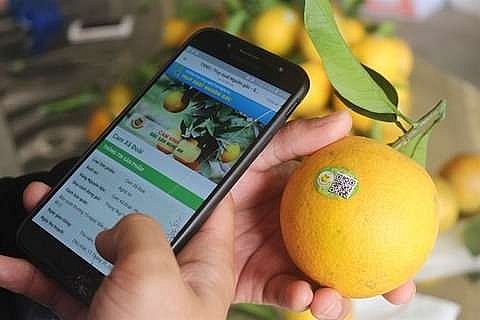Exports to EU open opportunity to expand markets for VN firms
 |
| Checking orange’s origin by using QR Code in the central province of Nghe An. Agricultural products’ quality has been in top of EU market’s requirement. - VNA/VNS Photo Nguyen Oanh |
Pham Van Cuong, general director of G.O.C Food Processing Export Joint Stock Company told the 2018 Viet Nam – EU Trade Forum, themed ‘Agro-trading: Partnership for sustainable development’ held in Ha Noi on Thursday this would be an opportunity for Vietnamese firms to improve their management experience.
With three factories specialising in producing and supplying agricultural products for export, he said exporters to the EU also have to pay attention to policies relating to environmental protection, energy saving and labour standards.
He said his company has not set a high profit target when exporting to the EU but meeting the market’s requirements would help them export elsewhere.
Meanwhile, specialist Hadyn Craig from the UK Centre for Scientific and Technical Creativity noted that consumers’ health in the EU has been considered as one of important factors for development. It was the reason that controlling quality has always been a requirement for products, especially imported agricultural ones.
Nguyen Thi Huyen, director of VINA SAMEX JSC said the trend in the EU was to use natural products.
“Therefore, Vietnamese enterprises should not only strictly control food safety and quality of products, but also promote organic and clean products,” she said, adding they have trained farmers not to use fertiliser and chemicals.
Deputy Minister of Industry and Trade, Cao Quoc Hung said the EU is a prosperous economic region with GDP accounting for 23 per cent of the world’s nominal GDP and annual average per capita income up to US$40,890.
He said Viet Nam has advantages in production and exports of tropical agricultural products to the EU and will have more when the EU-Viet Nam Free Trade Agreement (EVFTA) takes effect. However, this market has strict regulations on product quality and food hygiene and safety.
However, the Government, businesses and consultants should join hands to take advantages of EVFTA, he said.
French agricultural counselor in Viet Nam, Alexandre Bouchot, said it is crucial to decentralise the management of food policy, promote local initiatives, enhance the attraction of enterprises’ investment in agriculture and focus on training to meet requirements.
Many trade experts said that the first barrier for exports of Viet Nam’s agricultural products to the EU was a lack of links between farmers and enterprises.
Tran Van Cong, deputy director of the Agro Processing and Market Development Authority under the Ministry of Agriculture and Rural Development, said in addition to preferential land prices and interest rate, the Government has also encouraged businesses investing in high-tech and clean agriculture.
He said investing in high-tech agriculture would not only improve product quality but also help firms join value chains, meet importers’ requirements and increase competitiveness.
“Viet Nam welcomes and is ready to apply preferential mechanisms to encourage investment and co-operation from EU firms in agricultural processing,” he added.
According to the Ministry of Industry and Trade, the two-way trade between Viet Nam and EU reached $50 billion in 2017, with exports of agricultural products from Viet Nam to the EU exceeding $5 billion.
Last year, the country’s total export value of agricultural products posted a 4.5 per cent year-on-year rise to VND768.2 trillion ($33.4 billion).
The EU was second among export markets of Viet Nam, with 18 per cent of Viet Nam’s total agricultural products shipped to the market.
In the first 10 months of the year, the country’s export value of agricultural products reached $4.3 billion, increasing 10 per cent from the same period last year and could surpass the whole year’s set target.
The forum offered an opportunity for economic experts to share difficulties and challenges for Viet Nam – EU trade, helping enterprises to remove barriers and obstacles in production and business as well as providing updates and forecasts on the EU’s policies and regulations for imported agriculture products.
What the stars mean:
★ Poor ★ ★ Promising ★★★ Good ★★★★ Very good ★★★★★ Exceptional
 Tag:
Tag:
Related Contents
Latest News
More News
- Vietnam’s industrial output hits seven-year high in 2025 (January 06, 2026 | 17:47)
- GELEX’s credit rating outlook upgraded to 'Positive' by VIS Rating (January 06, 2026 | 16:49)
- Finance sector lays firm groundwork for 2026 after major reform (January 06, 2026 | 15:30)
- Vietnam’s seafood exports surpass $11 billion in 2025 (January 06, 2026 | 08:51)
- Vietnam GDP posts second-strongest growth since 2011 (January 06, 2026 | 08:35)
- Double-digit GDP growth within reach with shift to higher-value expansion (January 06, 2026 | 08:33)
- Takeda Vietnam awarded for ongoing support of Vietnam’s sustainability efforts (December 31, 2025 | 21:00)
- Vietnam's retail market tops $269 billion in 2025 amid e-commerce boom (December 31, 2025 | 19:00)
- Stronger legal framework urged as trade fraud surges online (December 31, 2025 | 18:58)
- FPT exports first chip shipment to Japan (December 31, 2025 | 10:47)




















 Mobile Version
Mobile Version